|
|
|
 |
|
“PHARAOH, KING OF
EGYPT HAD GONE UP AND CAPTURED
GEZER AND BURNT IT WITH FIRE...AND HAD GIVEN IT
AS DOWRY TO HIS DAUGHTER, SOLOMON'S WIFE"
FIRST KINGS 9:16
|
|
|
 |
|
 |
| |
| Out of King
Solomon’s 700 princesses and 300 concubines,
Pharaoh’s daughter is the only one singled out.
We don’t know her name but we do know that her
father presented Solomon with a prime piece of real
estate, a property that the Israelites from the time
of Joshua had not succeeded in conquering.
Gezer was strategically located with a 350 degree
view of the Valley of Aijalon and the approaches to
Jerusalem from the Via Maris, the coastal highway
leading from Egypt to Mesopotamia. And in real
estate, as we all know, location is everything. |
| |
|
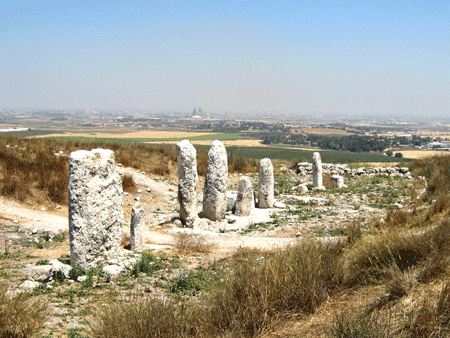 |
|
Photo: Gila
Yudkin |
|
Beyond the row of standing stones
lies the strategic Aijalon Valley |
| |
Solomon didn’t have
to go to the bankers to take out a subprime mortgage
or invest in a hedge fund. Many scholars
believe the marriage and the dowry gift were an
acknowledgement that the nation of Israel, united by
David and consolidated by Solomon, was a force to be
reckoned with.
Pharaoh's daughters did not ordinarily marry outside
their own family. And they certainly didn’t
leave Egypt. Perhaps this marriage indicates
the weakness of the Egyptian kingdom at this time,
as well as Solomon’s strength.
Imagine the chutzpah of a descendent of former
Egyptian slaves (remember the Exodus story) becoming
Pharaoh’s son-in-law. The marriage alliance
is, in fact, seen by scholars as the reason for the
increase in trade with Egypt reported in First Kings
10: 28-29.
In a suburb of old Jerusalem, skilled stone masons
were brought in from Phoenicia by Solomon to
construct a house customized for his Egyptian bride.
The menial work was done by Amorite, Hittite,
Perizzite, Hivite, and Jebusite captives. The
interior of the MacMansion was decorated with
imported cedar and cypress wood from Lebanon.
When the house was finished, Pharaoh’s daughter
moved out of the city of David, for Solomon said,
“My wife shall not live in the house of David, king
of Israel, for the places to which the ark of the
Lord has come are holy.” (Second Chronicles 8:11)
By the way, the 999 other chicks in Solomon’s harem
did not have their own pad, much less a mansion.
Unfortunately there is a sad finale to this romance.
By the end of his reign, Solomon’s heart was pulled
towards the gods of his foreign wives. The
punishment meted out to Solomon’s son Rehoboam was
no less than the loss of nine-tenths of his kingdom.
When we visit Gezer on tour, we can consider whether
Solomon’s wife ever visited the site given as a
wedding present to her husband. For sure, it
wouldn’t have been a 45-minute hike as it is for us
today. I’ll bet that Pharaoh’s daughter was
chauffeured in great style in one of Solomon’s 1400
imported chariots. (Second Chronicles 1:14) |
| |
|
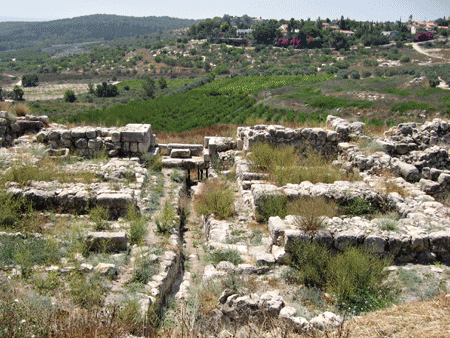 |
|
Photo: Gila
Yudkin |
|
10th century BC "Solomonic Gate"
at Tel Gezer |
| |
| She would have
entered through an exceptionally well-built
six-chambered gate constructed with white limestone
ashlars. Plastered benches ran around the
three walls of each of the inner chambers. The
chambers were roofed, which was considerate of the
city guards. |
| |
|
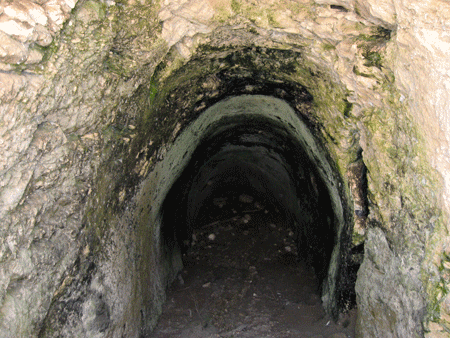 |
|
Photo: Gila
Yudkin |
|
Perhaps the servants of Pharaoh's
daughter fetched water
from this 10th century BC water system |
| |
But the most
interesting features of the town would have long
been buried by Solomon’s day. They are 10
monoliths, or monumental stones called massebot
in the Hebrew Bible, some of them reaching the
height of over nine feet. They were discovered
by R.A.S. Macalister, a young Irish archeologist in
the early twentieth century.
Macalister worked alone except for an Egyptian
foreman. He employed two hundred laborers from
a nearby Arab village. Macalister worked year
round in the field with interruptions only for an
occasional winter storm, outbreaks of cholera or
troubles with his Turkish excavation permit. |
| |
|
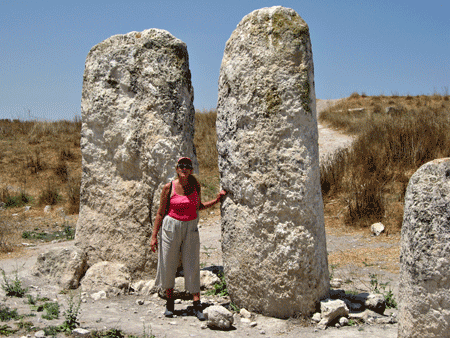 |
|
Photo: Gila
Yudkin |
|
The monoliths or massebot
probably represented an alliance or treaty |
|
|
|
The monoliths, dating to about 1500 BC, were found
lying down and have been re-erected by
archeologists. They originally stood in a
north-south alignment. Nearby was a plastered
basin which may have served as a container for a
blood libation poured during a treaty ceremony.
A ritual of this type is described in Exodus chapter
24 after Moses brought the ten commandments down
from Mount Sinai. Moses also set up twelve
standing stones, representing the twelve tribes. |
|
|
|
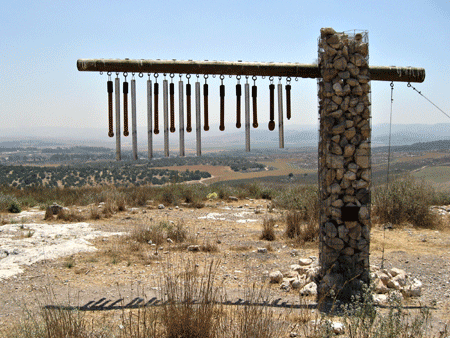 |
|
Photo: Gila
Yudkin |
|
Artwork at Gezer inspired by the
massebot or monoliths |
|
|
There’s lots of Bible to talk about at Gezer.
Many scholars who believe that Solomon was the
author of the Song of Songs suggest that he is
addressing Pharaoh’s daughter as the ultimate woman.
In the first song he says, “I compare you, my love,
to a mare among Pharaoh’s chariots.”
At Gezer we can also look at Proverbs, another of
Solomon’s works, and fantasize about which were
inspired by his union with Pharaoh’s daughter.
Perhaps “She is like the ships of the merchant; she
brings her food from far away. She rises while
it is still night and provides food for her
household and tasks for her servant-girls. She
considers a field and buys it, with the fruit of her
hands she plants a vineyard.” (Proverbs 31: 14-16) |
|
|
|
Copyright 2008, 2009 Gila Yudkin. Permission
needed for any reuse. |
|
Postscript |
| |
|
Early in July 2009, I had the honor of
guiding a group led by Dr. Paige Patterson,
President of Southwestern Baptist
Theological Seminary in Texas. Because
the seminary is co-sponsoring the
archeological dig at Tel Gezer, we got a VIP
tour of both the dig and the artifacts by
directors Dr. Steve Ortiz and Dr. Sam Wolff.
The present dig is focused on the Iron Age,
which is the Israelite period. I found
it very exciting to be at Gezer once again
and to meet the dig directors and the
volunteer students who are giving us more
information about this important biblical
site. |
| |
|
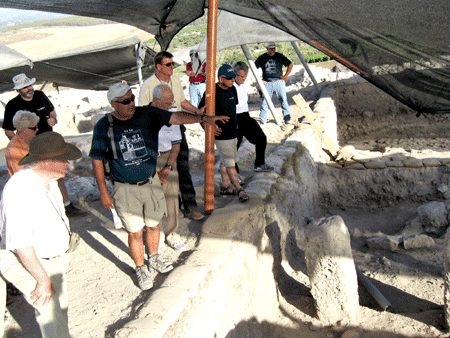 |
|
Photo: Gila
Yudkin |
|
Co-director Dr. Steve
Ortiz (with out-stretched arm) giving tour
at Gezer |
| |
|
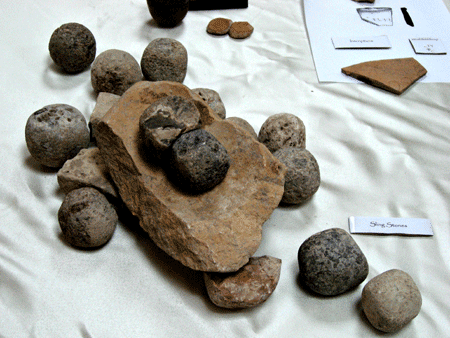 |
|
Photo: Gila
Yudkin |
|
Sling stones unearthed at
Tel Gezer during the 2009 season |
| |
|
Below is a September 2009 update from Dr.
Steve Ortiz: |
| |
"This summer was the fourth season for
the Tel Gezer Excavation and Study
Program. This joint project is sponsored
by Southwestern Baptist Theological
Seminary and the Israel Antiquities
Authority. Dr. Steve Ortiz and Dr.
Sam Wolff co-direct the excavations with
the participation of a consortium of
academic institutions.
Tel Gezer, the most important site in
the northern Shephelah region of Israel,
is an ideal site to address several issues
arising from current research. The
research strategy is to uncover the
ancient city during the Iron Age.
The excavations have focused on the
south-eastern slope of the western hill
where previous excavations have revealed
that there are several occupational phases
of the Iron Age city.
|
This past summer was a very productive
excavation season. Over 80 students
and staff, mostly from North America spent
five weeks working on the tel. The
majority of the excavation focused on
uncovering a massive destruction dating to
the 8th century BCE. This
destruction is well attested in the
historical sources and is dated to the
campaigns of Tiglath Pileser III.
Most of this destruction was concentrated
in the domestic quarter of the site.
|
Students spent hours at a time slowly
uncovering nearly a hundred vessels and
finds found in an Israelite four-room
house. It was a slow process of
excavating the collapsed mud-bricks that
sealed the contents of the house.
|
Another group focused on the
fortification system as they worked on the
slope of the tel. This was very
strenuous work as volunteers removed large
amounts of erosion and slope wash to
uncover a massive stone rampart, part of
the fortification system that abutted the
city wall. In the process, part of
the large Canaanite city wall was also
exposed underneath this stone
fortification.
|
Based on the results since excavations
started in the summer of 2006 -- we have
defined the major components of the 8th
century city during the time of Uzziah, on
the eve of the Assyrian destruction.
The Solomonic six-chambered gate was
reused as was the casemate wall.
Major components were rebuilt, such as a
belt of three major administrative
buildings west of the gate built along the
city wall. Two of these buildings
were typical square-shaped tripartite
pillared buildings. The third was an
industrial complex with a large stone with
a sump probably used for processing of
oil.
|
About 60 meters (125 feet) from the
city gate and plaza was the start of the
domestic quarter where a large Israelite
house was discovered. This is part
of a series of homes found on the western
hill of the tel. In the future the
project hopes to uncover the history of
city planning and urbanization at Gezer
throughout its history during the
Israelite Period, particularly as it
relates to its position as a site that
sits between the north, south, and the
coastal plain."
Dr. Steve Ortiz,
Associate Professor of Archeology and
Biblical Backgrounds, Southwestern Baptist
Theological Seminary
|
|
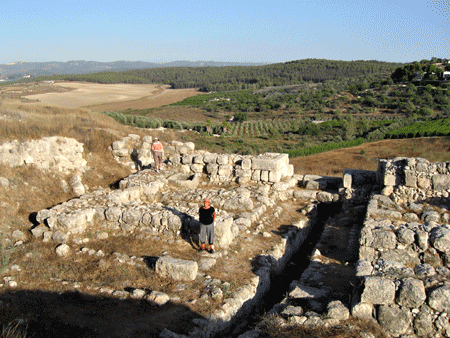 |
|
Photo: Gila
Yudkin |
|
Solomonic Gate at Tel
Gezer, 2009 season |
| |
|
COMING TO
JERUSALEM?
BOOK GILA for your customized private tour |
| |
|
Gila Yudkin
is a Connecticut Yankee who has lived in
King Solomon’s court for three decades.
But not in the harem! She’d love to
share her knowledge and perspective on
Solomon at Gezer if your group is willing to
engage in an easy 45-minute hike during the
winter season. (The bus is not able to
come close to the tel – this site is really
off the beaten tourist routes!) It’s
best to book Gila early and be sure to bring
along some
vitamin M! |
| |
| If you are contemplating leading a tour to
the Holy Land or know someone who is, don’t
miss Gila’s tips about do's and don'ts guaranteed to make your Holy Land
pilgrimage a rave success. Read
Tips from A to Z for Holy
Land Tour Leaders. |
| |
|
More Biblical Archeology: |
|
|
|
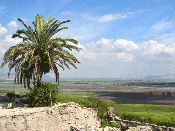 |
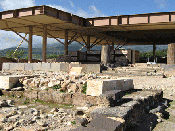 |
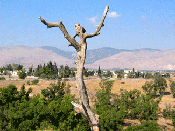 |
|
Megiddo / Armageddon |
Joshua burning Hazor |
Saul's body at Beth Shean |
|
|
|
|
|
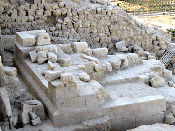 |
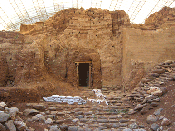 |
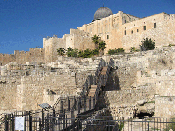 |
|
Herod's Tomb at Herodion |
Abraham at Dan? |
Solomon's Palace |
|
|
|
|
|
|
|
GILA
YUDKIN
•
TCHERNIKOVSKI
64A
•
JERUSALEM
•
ISRAEL
gila@itsgila.com
HOME
•
BOOK
GILA •
TIPS
FOR TOURS •
ABOUT GILA
|
|

